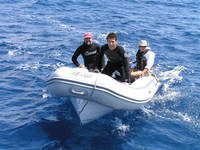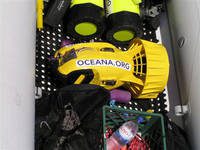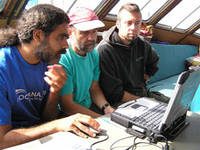June 13, 2005
Getting ready for work on the Gorringe Ridge. Monday, June 13th, 2005
 After 24 hours of navigation since we left the port of Lagos and proceeding on southwest direction, we have arrived at Gorringe. The crew prepares an anchor buoy to mark the place, which also serves divers as a guide when they sumerge. Finding an adequate spot to anchor has not been easy. Using the Ranger’s sonic instruments, the captain has selected several spots within a 40-50 meter diameter, down to a depth of 30 meters. Bibi, the sailor from Cambados, organizes the auxiliary boat she will use to transport the four divers, the filming gear and a torpedo. The torpedo is a submergible device equipped with an electric motor and a propeller, and it is used by divers to go for long distances underwater, without much effort. At first dive, only a pair of divers will go down, these will be Mar and Dana Harlow. In addition to doing recognizance of the spot, they make sure the torpedo works well and they take a photographic camera along with them.
After 24 hours of navigation since we left the port of Lagos and proceeding on southwest direction, we have arrived at Gorringe. The crew prepares an anchor buoy to mark the place, which also serves divers as a guide when they sumerge. Finding an adequate spot to anchor has not been easy. Using the Ranger’s sonic instruments, the captain has selected several spots within a 40-50 meter diameter, down to a depth of 30 meters. Bibi, the sailor from Cambados, organizes the auxiliary boat she will use to transport the four divers, the filming gear and a torpedo. The torpedo is a submergible device equipped with an electric motor and a propeller, and it is used by divers to go for long distances underwater, without much effort. At first dive, only a pair of divers will go down, these will be Mar and Dana Harlow. In addition to doing recognizance of the spot, they make sure the torpedo works well and they take a photographic camera along with them.
 It is estimated there are around 100,000 underwater mountains in the world, 800 of them are located in the North Atlantic Ocean. These areas of shallow waters provide particular characteristics both for oceanic movement and for marine fauna. The emergence of nutrients around the summit is a frequent occurrence, phenomena linked to ascending whirlpools. As these areas provide a resting place in the middle of the ocean, numerous species – some of them commercially in demand – gather here to reproduce and feed. Fish of slow growth characteristics and great longevity are commonly found here; for instance, the orange roughy ( Hoplosthetus atlanticus ) and the black scabbardfish ( Aphanopus carbo ). Therefore, these are very vulnerable species to abusive fishing methods.
It is estimated there are around 100,000 underwater mountains in the world, 800 of them are located in the North Atlantic Ocean. These areas of shallow waters provide particular characteristics both for oceanic movement and for marine fauna. The emergence of nutrients around the summit is a frequent occurrence, phenomena linked to ascending whirlpools. As these areas provide a resting place in the middle of the ocean, numerous species – some of them commercially in demand – gather here to reproduce and feed. Fish of slow growth characteristics and great longevity are commonly found here; for instance, the orange roughy ( Hoplosthetus atlanticus ) and the black scabbardfish ( Aphanopus carbo ). Therefore, these are very vulnerable species to abusive fishing methods.

Gorringe Ridge is a group of underwater mountains of volcanic origin. Great part of their surface is formed by hard substrate where filter-feeding invertebrates ans species associated to algae forests proliferate. As soon as the divers resurface, they tell us of their experience. There is a strong current and the scenery is covered mostly by brown algae ( Zonaria tournefortii ) and Laminaria sp. The most abundant species sighted, were grey triggerfish ( Balistes carolinensis – later changed to Balistes capriscus ), almaco jack ( Seriola rivoliana ), Mediterranean rainbow wrasse ( Coris julis ), swallowtail seaperch ( Anthias anthias ), John Dory ( Zeus faber ) and Mediterranean slipper lobster ( Scyllarides latus ).
These mountains belong to the Economic Exclusive Zone of Portugal, there is a proposal to have this area declared Conservation Special Area ( CSA ) and includa them in Red Natura 2000.
We spent the night adrift on the summits of Gorringe. We will see what tomorrow brings.


